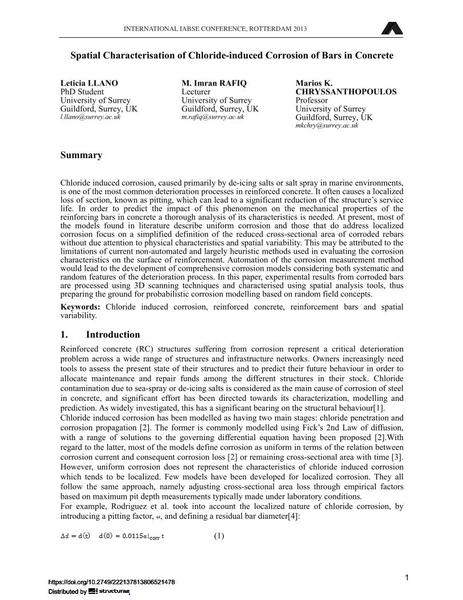Spatial Characterisation of Chloride-induced Corrosion of Bars in Concrete

|
|
|||||||||||
Détails bibliographiques
| Auteur(s): |
Leticia Llano
M. Imran Rafiq Marios K. Chryssanthopoulos |
||||
|---|---|---|---|---|---|
| Médium: | papier de conférence | ||||
| Langue(s): | anglais | ||||
| Conférence: | IABSE Conference: Assessment, Upgrading and Refurbishment of Infrastructures, Rotterdam, The Netherlands, 6-8 May 2013 | ||||
| Publié dans: | IABSE Conference, Rotterdam, May 2013 | ||||
|
|||||
| Page(s): | 550-551 | ||||
| Nombre total de pages (du PDF): | 8 | ||||
| Année: | 2013 | ||||
| DOI: | 10.2749/222137813806521478 | ||||
| Abstrait: |
Chloride induced corrosion, caused primarily by de-icing salts or salt spray in marine environments, is one of the most common deterioration processes in reinforced concrete. It often causes a localized loss of section, known as pitting, which can lead to a significant reduction of the structure’s service life. In order to predict the impact of this phenomenon on the mechanical properties of the reinforcing bars in concrete a thorough analysis of its characteristics is needed. At present, most of the models found in literature describe uniform corrosion and those that do address localized corrosion focus on a simplified definition of the reduced cross-sectional area of corroded rebars without due attention to physical characteristics and spatial variability. This may be attributed to the limitations of current non-automated and largely heuristic methods used in evaluating the corrosion characteristics on the surface of reinforcement. Automation of the corrosion measurement method would lead to the development of comprehensive corrosion models considering both systematic and random features of the deterioration process. In this paper, experimental results from corroded bars are processed using 3D scanning techniques and characterised using spatial analysis tools, thus preparing the ground for probabilistic corrosion modelling based on random field concepts. |
||||
